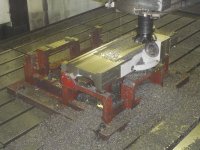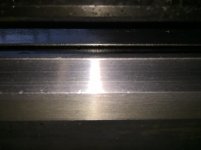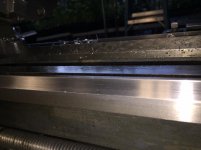How to install the app on iOS
Follow along with the video below to see how to install our site as a web app on your home screen.
Note: This feature may not be available in some browsers.
You are using an out of date browser. It may not display this or other websites correctly.
You should upgrade or use an alternative browser.
You should upgrade or use an alternative browser.
Bed ways on heavy 10R grooved 4/1000 can I have it machined?
- Thread starter Red1fire
- Start date
- Replies 28
- Views 7,437
10KPete
Hot Rolled
- Joined
- Dec 21, 2008
- Location
- Nordland, WA
You don't say how you measured the wear, what datums, or where the wear is. BUT, if there is truly .004" of
bed wear on the carriage Vees and it's the usual area in front of the chuck then the machine is in good
condition. Barring other conditions, unless you propose to do super precision work on parts less than, say,
3/8" dia. you have no worries. Save your money for other things. I'll add that the carriage underside typically
wears more than the bed. More on the left than the right. But unless that wear has resulted in the cross slide
being out of square with the spindle, it's no issue.
Pete
bed wear on the carriage Vees and it's the usual area in front of the chuck then the machine is in good
condition. Barring other conditions, unless you propose to do super precision work on parts less than, say,
3/8" dia. you have no worries. Save your money for other things. I'll add that the carriage underside typically
wears more than the bed. More on the left than the right. But unless that wear has resulted in the cross slide
being out of square with the spindle, it's no issue.
Pete
Measured the wear with a starrett last word dial indicator while adjusting the tail stock. Got the tail stock 100% on but found the dip in the bed close to the chuck. Would like to have it to factory spec. I've replaced many parts and dont want to do it half way. Anyone had one milled before. If so what was your experience.
Derek Smalls
Stainless
- Joined
- Jan 6, 2014
- Location
- Coventry RI
Measured the wear with a starrett last word dial indicator while adjusting the tail stock. Got the tail stock 100% on but found the dip in the bed close to the chuck. Would like to have it to factory spec. I've replaced many parts and dont want to do it half way. Anyone had one milled before. If so what was your experience.
Could you elaborate on your process a bit, I'm not understanding what you did at all or what your numbers mean.
10KPete
Hot Rolled
- Joined
- Dec 21, 2008
- Location
- Nordland, WA
Sure, look for posts by 'xplodee' or 'Thomas Utley' on their rebuilds. On this board. And others.
Pete
Pete
iwananew10K
Diamond
- Joined
- Sep 12, 2010
- Location
- moscow,ohio
Don't rely on a level laid across the ways for anything other than roughing it in,the tops of the v ways are not a very good reference surface, and since it is a used machine essentially nothing can be considered a good reference surface.
Setting up a used small machine with a precision level is a good way to make yourself go nutty.
Rough it in "level", test cuts from there to dial it in.
Setting up a used small machine with a precision level is a good way to make yourself go nutty.
Rough it in "level", test cuts from there to dial it in.
stephen thomas
Diamond
- Joined
- Jun 3, 2001
As has been stated, .004 wear is barely out of new, as far as performance. Unless there's something else going on. If you truly only have .004 wear and can see the result in your work, it is not the lathe.
If you can see it in the work (with only .004 bed wear) & have ruled out set up and operator training, it is possible the headstock was removed at some time and possibly installed with dirt, paint, ding, or other factor that might mean it is no longer aligned with the bed.
If you grind the bed, the TS base and the headstock base will need re-scraped for fit and alignment; and the carriage will need rescraped to fit. You may also then need to shim the rack and re-scrape the cross-slide for the proper "squareness" (should actually cut hollow) of the cross slide.
Yes, many on here have done it.
I planed my 10K 54"; but the original bed had more like .050" wear.
Smaller lathe than a heavy 10 but as far aw what needs machined and scraped, not really much difference.



I could only get to within about .002 - .004 of total geometry with my planer, and scraped the bed. (It would be possible to selectively shim and machine closer on the planer, but at a certain point scraping is faster). A way grinder could get closer. Or a planer with with less worn ways. Everything still needs scraped to fit, whether planed or ground.
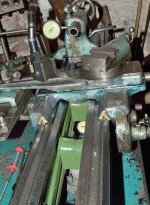
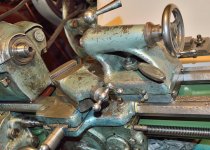
smt
If you can see it in the work (with only .004 bed wear) & have ruled out set up and operator training, it is possible the headstock was removed at some time and possibly installed with dirt, paint, ding, or other factor that might mean it is no longer aligned with the bed.
If you grind the bed, the TS base and the headstock base will need re-scraped for fit and alignment; and the carriage will need rescraped to fit. You may also then need to shim the rack and re-scrape the cross-slide for the proper "squareness" (should actually cut hollow) of the cross slide.
Anyone had one milled before. If so what was your experience.
Yes, many on here have done it.
I planed my 10K 54"; but the original bed had more like .050" wear.
Smaller lathe than a heavy 10 but as far aw what needs machined and scraped, not really much difference.



I could only get to within about .002 - .004 of total geometry with my planer, and scraped the bed. (It would be possible to selectively shim and machine closer on the planer, but at a certain point scraping is faster). A way grinder could get closer. Or a planer with with less worn ways. Everything still needs scraped to fit, whether planed or ground.


smt
DMF_TomB
Diamond
- Joined
- Dec 13, 2008
- Location
- Rochester, NY, USA
is it hardened or can it be milled ?
.
i use a cnc gantry mill to machine parts to less than .0005" over part lengths of 40 to 80" in straightness, flatness quite often
.
i shim parts often using .0010" and .0012" (.03mm) feeler gage material to get to .0002" alignment before machining and use a torque wrench to 2 to 10 ft lbs torque and support part in well thought out way to minimize distortion from gravity and hold down bolt torque. 3 supports are often used to not twist part trying to secure it in a fixture.
.
finish milling passes are often only .001" or even .0005" taking a magic marker mark off to indicate cleaned surface full length. i always indicate to confirm within less than .0005" , often have to use a much smaller than 6" facemill. as cutter pushes part while machining. finish cutters are often a much smaller size to minimize distortion while machining. also coolant is temperature controlled and part must not be hot when finish machining. part can change or distort as it cools
.
some parts i have to loosen all bolts and indicate again to confirm still straight, flat, not twisted, etc when just sitting in fixture with nothing pushing or distorting it. i usually machine pads the part sits on every time fixture goes on machine and confirm the pads parts sits on are planar or flat within .0003". i shim reworked parts when they do not require top and bottom surfaces parallel to one another
.
a lot of rebuilt machines where turcite was very worn the other cast iron half is worn .002" to .005", usually surface is milled and scraping only to add oil retention scraped surface pattern to it
.
i use machine to check a 36" by 36" granite square periodically. if machine is moving in straight line and perpendicular then it will indicate that granite square has straight and perpendicular surfaces
.
i use a cnc gantry mill to machine parts to less than .0005" over part lengths of 40 to 80" in straightness, flatness quite often
.
i shim parts often using .0010" and .0012" (.03mm) feeler gage material to get to .0002" alignment before machining and use a torque wrench to 2 to 10 ft lbs torque and support part in well thought out way to minimize distortion from gravity and hold down bolt torque. 3 supports are often used to not twist part trying to secure it in a fixture.
.
finish milling passes are often only .001" or even .0005" taking a magic marker mark off to indicate cleaned surface full length. i always indicate to confirm within less than .0005" , often have to use a much smaller than 6" facemill. as cutter pushes part while machining. finish cutters are often a much smaller size to minimize distortion while machining. also coolant is temperature controlled and part must not be hot when finish machining. part can change or distort as it cools
.
some parts i have to loosen all bolts and indicate again to confirm still straight, flat, not twisted, etc when just sitting in fixture with nothing pushing or distorting it. i usually machine pads the part sits on every time fixture goes on machine and confirm the pads parts sits on are planar or flat within .0003". i shim reworked parts when they do not require top and bottom surfaces parallel to one another
.
a lot of rebuilt machines where turcite was very worn the other cast iron half is worn .002" to .005", usually surface is milled and scraping only to add oil retention scraped surface pattern to it
.
i use machine to check a 36" by 36" granite square periodically. if machine is moving in straight line and perpendicular then it will indicate that granite square has straight and perpendicular surfaces
Attachments
10KPete
Hot Rolled
- Joined
- Dec 21, 2008
- Location
- Nordland, WA
That, my friend, is a minor scratch.
Pete
Pete
10KPete
Hot Rolled
- Joined
- Dec 21, 2008
- Location
- Nordland, WA
You're welcome! That is why pictures are so important with these things. Machine tools are systems. Many
parts working together and so one must know the whole to assess it. Keep at it, attention to detail will
lead to a successful completion.
Pete
parts working together and so one must know the whole to assess it. Keep at it, attention to detail will
lead to a successful completion.
Pete
stephen thomas
Diamond
- Joined
- Jun 3, 2001
That, my friend, is a minor scratch.
Pete - I beg to differ. As you note the "scratch" is inconsequential.
However, the photo shows a wear ridge, probably at least .015 - .020 wear, could be more including the carriage wings. Somewhere with this much wear, the carriage becomes unstable. Probably fits relatively solidly in the trough, but begins to drift further out on the unworn parts of the ways. Working up close to the spindle, it will rise suddenly toward the unworn parts of the ways beside the headstock.
This is probably why he can indicate .004" with relatively crude methods. The ways have to be worn way beyond that, to actually get much indication on the cosine at all.
Adventures With Klunkers
So, if the photos don't lie, your bed is a candidate for re-grinding and your carriage & TS for re-scraping to match.
Nevertheless, if you just want to use the lathe, many of us have made very accurate, complex parts on lathes with a lot more wear. Mine had at least twice the wear of yours; probably 3x, before i finally had some spare time and swapped it for a longer bed (Thanks! Tommy 1010) and re-planed/rescraped the donor bed.
No insults intended, but if you are experienced running a lathe, you can certainly make your own decision based on cost and convenience. If you are "less" experienced, I still say use it and get some more experience - the current condition may occasionally be a nuisance, but it will not be what limits your work.
Farmed out, you are looking at $1,000 - $1,500 plus shipping charges to do the basics including bed, scraping carriage and TS, and shimming up the TS. Maybe twice that to do it all including cross slide, compound and headstock.
smt
iwananew10K
Diamond
- Joined
- Sep 12, 2010
- Location
- moscow,ohio
In the second pic you can even see where the wear ridge begins to fade as it gets closer to the lesser used area right near the headstock.
10KPete
Hot Rolled
- Joined
- Dec 21, 2008
- Location
- Nordland, WA
OK, I must be going blind then. Are you guys saying that the bright area along the top of the vee is a ridge?
Looks to me like a reflection off the top corner.??? I'm staring at it but......
Geez, I hope I just didn't give Shawn some bad advise based on what I thought I saw.
Shawn, maybe you should take some more pics so these guys can check it out better.
I apologize if I've screwed up here.
Pete
Looks to me like a reflection off the top corner.??? I'm staring at it but......
Geez, I hope I just didn't give Shawn some bad advise based on what I thought I saw.
Shawn, maybe you should take some more pics so these guys can check it out better.
I apologize if I've screwed up here.
Pete
fciron
Stainless
- Joined
- Oct 14, 2009
- Location
- Louisville, KY, USA
That's not a ridge, it's a corner. The ridge appears about a 16th of an inch below the top of the V add on this picture of my Heavy 10. (A lathe with which I have rebuilt the spindle of my 20" drill press without any issues and with which I keep my blacksmith shop running.)
It's a South Bend. If you want to hold tenths you'll need to check everything every time.
https://farm1.staticflickr.com/725/23062544979_3efc8d3a00.jpg
It's a South Bend. If you want to hold tenths you'll need to check everything every time.
https://farm1.staticflickr.com/725/23062544979_3efc8d3a00.jpg
stephen thomas
Diamond
- Joined
- Jun 3, 2001
Well we are back to the old conundrum of trying to diagnose from less than ideal photos, where perspective and shadow may provide illusions as much as information.
That said, it sure looks like a wear ridge.
smt
That said, it sure looks like a wear ridge.
smt
10KPete
Hot Rolled
- Joined
- Dec 21, 2008
- Location
- Nordland, WA
Well we are back to the old conundrum of trying to diagnose from less than ideal photos, where perspective and shadow may provide illusions as much as information.
That said, it sure looks like a wear ridge.
smt

Pete
Derek Smalls
Stainless
- Joined
- Jan 6, 2014
- Location
- Coventry RI
So, the photos aside, I'm still curious how the OP measured the .004" wear exactly. All he said was that he did it while adjusting the tail stock and that he managed to get the tail stock 100%. Did he mount an indicator on the tail stock and sweep the other way surfaces with it? Or is this taper he measures in a shaft(with the ends of the shaft being the same size)? I have no idea what he's meaning. Am I the only one who is missing something?
Similar threads
- Replies
- 49
- Views
- 3K
- Replies
- 5
- Views
- 535
- Replies
- 15
- Views
- 523
- Replies
- 70
- Views
- 3K


